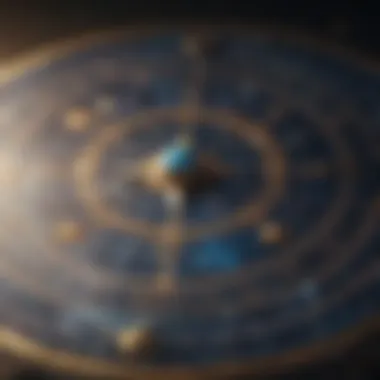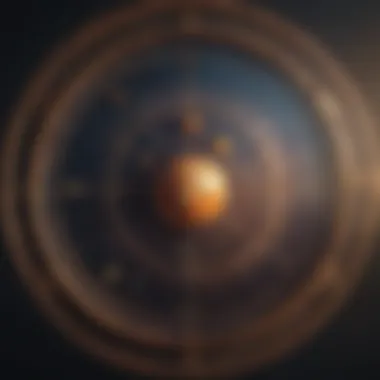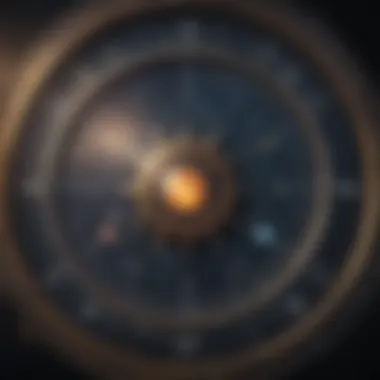Interpreting Relationship Star Charts in Astrology


Intro
Astrology is a fascinating field that delves into the interconnectedness of celestial movements and human existence. Within this realm, relationship star charts serve as invaluable tools, offering insights into the dynamics of interpersonal connections rooted in astrological principles. Whether one is seeking to understand romantic partnerships, friendships, or professional ties, the stars can illuminate patterns, strengths, and areas for growth.
Through practical examples and a breakdown of foundational concepts, we invite you to explore the intricacies of astrology and how it relates to the relationships that shape our lives. Understanding these cosmic influences can foster connections that are meaningful and fulfilling.
Characteristics of Each Zodiac Sign
Zodiac signs embody unique personality traits that influence how individuals relate to one another. Let's take a look at the key elements for each sign:
Overview of personality traits
- Aries: Bold and adventurous, often taking the lead in relationships.
- Taurus: Steadfast and reliable, valuing loyalty and sensual pleasures.
- Gemini: Inquisitive and social, thriving on communication and intellectual exchanges.
- Cancer: Intuitive and nurturing, often seeking emotional connections.
- Leo: Charismatic and passionate, enjoying attention and admiration.
- Virgo: Analytical and detail-oriented, preferring stability and practicality.
- Libra: Diplomatic and charming, focused on harmony and balance in relationships.
- Scorpio: Intense and deep, often exploring the complexities of emotional intimacy.
- Sagittarius: Optimistic and freedom-loving, seeking adventure and growth.
- Capricorn: Ambitious and disciplined, valuing structure and responsibility.
- Aquarius: Innovative and independent, often embracing unconventional methods.
- Pisces: Compassionate and imaginative, drawn to deep emotional connections.
Strengths and weaknesses
Each sign has its strengths and weaknesses, influencing how they engage with others:
- Aries: Strengths include leadership and enthusiasm; weaknesses involve impulsiveness.
- Taurus: Strong work ethic and loyalty are notable; stubbornness can be an issue.
- Gemini: Quick wit promotes engagement; inconsistency may cause misunderstandings.
- Cancer: Empathy strengthens bonds; over-sensitivity can create conflict.
- Leo: Passion energizes connections, but arrogance might alienate others.
- Virgo: Organization fosters stability; critical nature may deter emotional exchanges.
- Libra: Diplomacy enhances relationship dynamics; people-pleasing tendencies can lead to resentment.
- Scorpio: Depth in connections is key; jealousy may hinder honest communication.
- Sagittarius: Their enthusiasm invites growth; lack of direction may confuse partners.
- Capricorn: Practicality ensures reliability; rigidity may stifle creativity and spontaneity.
- Aquarius: Innovative thinking sparks fresh ideas; detachment can create emotional distance.
- Pisces: Their compassion nurtures relationships; escapism might obscure reality.
Compatibility with other signs
Compatibility is influenced not only by individual traits but also by the elemental groupings of the zodiac:
- Fire Signs (Aries, Leo, Sagittarius): Tend to connect well with each other due to shared energy and enthusiasm.
- Earth Signs (Taurus, Virgo, Capricorn): Enjoy stability and practicality in relationships, fostering similar values.
- Air Signs (Gemini, Libra, Aquarius): Communicative and intellectually driven, often engaging in dynamic exchanges.
- Water Signs (Cancer, Scorpio, Pisces): Nurturing and emotional, typically understanding one another's depths.
Understanding these characteristics helps navigate interpersonal dynamics, offering a clearer sense of how different signs interact. As we delve further into the astrological insights, we will explore how these dynamics manifest in daily, romantic, and even professional contexts.
Understanding Astrological Charts
Astrological charts can seem daunting at first glance, yet they hold immense value in understanding the intricate dynamics of relationships. They serve as a cosmic map, guiding us through the complex interplay of emotions, desires, and compatibility between people. When delving into these charts, one unearths layers of insights that can enhance both personal growth and relational understanding.
The importance of grasping astrological charts can't be overstated. They not only spot the nuances that influence connections but also reveal underlying patterns that may not be evident at surface level. By deciphering elements like planets, signs, and houses, individuals can gain clarity on their interactions with others, which is essential for fostering deeper relationships.
Astrology isn't just a party trick; it’s a tool that can catalyze genuine understanding among individuals. Consider the myriad ways to interpret these charts to decode personality traits, emotional needs, and conflict styles. The knowledge derived from these interpretations can bolster empathy, leading to healthier and more fulfilling relationships.
Components of a Star Chart
Understanding the components of a star chart is crucial, as they each play a significant role in how relationships unfold. The chart primarily comprises three elements: planets, signs, and houses. These elements each contribute to the overall tapestry of astrological insight, allowing for a comprehensive view of dynamics in any relationship.
Planets and Their Significance
When examining astrological charts, planets act as the principal actors—each representing different emotional drives and life areas. For instance, Venus embodies love and connection, while Mars represents drive and passion. Recognizing the unique roles of these planets aids in interpreting emotional responses and relational motivations.
The key characteristic of planets is their symbolism, rooted deeply in both ancient mythology and modern astrological thought. This significance offers rich layers of understanding that can inform actions and decisions within relationships. Their influence is well-regarded by those seeking insights into interpersonal dynamics.
However, one must also recognize the disadvantages in relying solely on planetary placements. A planet's position doesn’t provide a full picture. For instance, while Venus may suggest strong romantic inclinations, its placement in a hard aspect with Saturn could indicate challenges in expressing those feelings.
Signs and Symbolism
Signs in astrology articulate the style with which planets express their energy. Each zodiac sign has its unique traits, tendencies, and symbolism, which contribute greatly to the relational dynamics between partners. Aries brings forth assertiveness, whereas Cancer introduces nurturing instincts. By understanding the characteristics of each sign, one can better anticipate emotional responses and interaction styles.
The key characteristic of signs revolves around their element and modality. These categories inform compatibility and engagement styles, which is beneficial for anyone looking to understand the subtleties of relationships. For example, fire signs often share a passion that can ignite friendships or romantic connections.
However, a unique feature of zodiac signs is their dual nature. A sign's positive attributes can sometimes mask or distort their less favorable traits. For example, a Libra’s love for harmony could lead to avoidance of conflict rather than resolution, which poses challenges in a relationship.
Houses and Their Roles
Houses represent different life areas and tap into the environmental context that affects astrological influences. Each house governs specific themes, such as relationships, work, home, and more. Understanding where planetary influences land in one’s houses can clarify which themes will be most impactful in relationship settings.
The key characteristic of houses is their intricate connection to individual life experience. The positions and aspects reveal which areas of life will receive the most energy and emphasis, illustrating where relationships could flourish or flounder.
Given this interrelationship, it can be a both a strength and weakness. The nuanced insight offered by houses can pinpoint areas of growth, but it can also overwhelm a beginner seeking simplicity. Familiarity with houses enables individuals to grasp where their emotional and practical energy is directed, a vital aspect of interpreting relationship dynamics.
The Birth Chart Explained
A birth chart is the ultimate representation of the cosmos at the moment of one’s birth, showcasing a snapshot of planetary positions and their relationships. Defining this chart is pivotal, as it lays the groundwork for understanding one's intrinsic traits and how they intersect with others.
Defining the Birth Chart
Defining the birth chart is akin to laying the foundation of a house; without a solid base, the house may crumble. This chart captures one’s individual astrological makeup, dictating personal strengths, areas of growth, and relational tendencies. The benefit of having a clear definition is that it opens doors to self-discovery and personal development.
This chart’s unique feature lies in its uniqueness. No two birth charts are alike, even for twins born minutes apart. Each aspect, angle, and placement tells a distinct story that provides insights on interactions with others, emphasizing its advantage in fostering self-awareness and relational understanding.
Calculating Your Chart
Calculating your chart involves knowing the exact time, date, and location of your birth. This data not only affects planetary placements but also determines the alignment of houses, which is crucial for a precise interpretation. An accurate chart stems from reliable sources, making it a beneficial practice for personal insight.
The unique aspect of this process is the digital tools available today, allowing anyone to calculate their charts easily. Many online platforms provide detailed breakdowns, though understanding the intricacies behind them adds depth to any interpretation. Technically, the downside could be the reliance on such platforms without grasping fundamental concepts may lead to superficial understanding.


Interpreting Basic Elements
Interpreting the basic elements in a birth chart—planets, signs, and houses—is fundamental for translating astrological insights into real-world scenarios. Each element works together like cogs in a machine, driving the narrative of one’s life and relationships. Focusing on these basic elements gives a well-rounded perspective, making it an important choice in astrology studies.
The benefit is the clarity each element provides in painting an accurate portrait of relational dynamics. Each planet, sign, and house combination illustrates diverse aspects of emotions and interactions.
However, the challenge may arise when interpreting too many elements at once. Overcomplicating the analysis can lead to confusion instead of clarity. Thus, prioritizing key elements and understanding their relationships becomes essential.
Understanding these foundational concepts, the journey through relationship star charts becomes clearer. Their significance stretches far beyond simple predictions and taps into the heart of human connection, offering profound opportunities for personal and relational growth.
The Role of Zodiac Signs in Relationships
Understanding how zodiac signs influence relationships is akin to unlocking a hidden treasure chest. Each sign possesses a unique energy that influences emotional expression, compatibility, and dynamics between partners. By analyzing these intricacies, individuals can gain deeper insights into their relationships. The exploration of zodiac signs not only sheds light on how people connect but also offers tools for personal growth and harmony.
Compatibility Among Zodiac Signs
Elements and Modalities
The division of zodiac signs into elements (fire, earth, air, water) and modalities (cardinal, fixed, mutable) plays a crucial role in compatibility. The interaction of these components helps in speaking about the fundamental nature of each sign. For instance, fire and air tend to fuel each other's passions and ideas, while earth and water signs may benefit from grounding emotional energies.
A significant characteristic of elements is their foundational role in relationship dynamics. Each element brings its own strengths and challenges. Fire signs, like Aries and Leo, are often more impulsive, while earth signs, such as Taurus and Capricorn, prefer stability and security. Knowing this can help partners understand their fundamental differences and synergies.
Understanding the interplay of elements can be advantageous for assessing relationship compatibility. Yet, relying solely on these can sometimes lead to misunderstandings. A unique feature is that while elements provide initial insights, personal growth and efforts play a critical role in shaping the relationship's outcome.
Understanding Affinities
When looking at zodiac signs, affinities describe how certain signs naturally connect. Each sign has its own compatible pairs that enhance relationship strengths. For example, a Libra might resonate well with a Gemini due to their shared air element, fostering communication and harmony.
The key here is the emotional and intellectual similarities that can create bonds. When couples share affinities, they might find understanding comes easier. This aspect can enrich relationships, though it might also cause complacency if both partners have too similar a nature.
One must note, however, that relying solely on affinities can create biases. Thus, while affinities highlight potential successes in relationships, they should not overshadow the individual efforts required for growth and understanding.
Contrasting Characteristics
As the name suggests, contrasting characteristics describe those signs that, while different, can wonderfully balance one another. For instance, a fiery Aries might find grounding with a careful Cancer. These contrasts create friction, but in turn, can spark significant growth and learning.
This contradiction is significant since it allows individuals to learn from each other, infusing freshness into a relationship. Partners can challenge beliefs and behaviors, remixing their emotional toolkit. Yet, this can also lead to tension if not addressed thoughtfully.
The unique feature here is that contrasting personalities can be both a blessing and a source of conflict. The balance between growth and friction requires vigilance and open communication between partners to harness the advantages fully.
How Sun Signs Affect Relationship Dynamics
Influence on Love Languages
Sun signs provide the backdrop for understanding how one expresses love. For example, a Cancer may lean towards nurturing gestures, while a Sagittarius may prefer adventurous experiences. Recognizing these differences enhances partner synergy.
The primary characteristic of this aspect is its ability to clarify what each partner values. These love languages offer insights into emotional needs and drive, allowing individuals to better cater to each other. Manufacturers of this love language may encounter a thrilling yet sometimes bewildering dynamic as they learn to balance these preferences.
However, failing to recognize one another's love languages can create barriers. When partners do not resonate with each other’s expressions, the bond may feel tense and unsatisfactory.
Emotional Expression
When it comes to emotional expression, sun signs can provide clarity on how partners navigate their feelings. For example, a Scorpio may express emotions more deeply, while an Aquarius might stay emotionally detached. These differences can significantly affect relationship communication.
The key characteristic lies in how these expressions can build or tear down connections. A partner aligned in emotional expression can strengthen intimacy, but if there’s a mismatch, it may lead to misunderstandings and frustration. Recognizing these patterns can support healthier communication, though at times, it might challenge partners to step outside their comfort zones.
Relating to one another’s emotional styles can potentially foster a deeper connection, but ignoring these differences can lead to feelings of alienation.
Conflict Resolution Styles
Conflict in relationships is inevitable, but the way each zodiac sign handles conflicts is largely shaped by their sun sign. For instance, a Leo may confront issues head-on, while a Virgo might prefer to analyze and resolve conflict quietly.
The characteristic of conflict resolution styles reveals the strategies and tools each partner employs to address disagreements. This knowledge is beneficial as it enables couples to adapt and find common ground. Partners aware of their styles can create a framework for navigating conflicts more effectively.
However, the disadvantage may arise from the polarized nature of conflict resolution. Different approaches can lead to further misunderstandings if not addressed properly. Thus, understanding these styles can empower couples, but it demands a commitment to adapt and learn from one another.
This practice goes beyond mere curiosity; it can enhance emotional connection, clarify misunderstandings, and even illuminate unresolved issues. The insights drawn from these interpretations can serve as a compass, guiding partners toward deeper understanding and enriching their bond.
Synastry: Comparing Two Charts
The Concept of Synastry
Synastry serves as a bridge, allowing us to observe the interplay between two charts. This method enables astrologers to explore the aspects formed between planets in different horoscopes. One key feature is that synastry isn’t just about identifying the harmonious aspects; it also sheds light on potential friction points.
Such contrasting elements make synastry a popular tool for many, as it offers a balanced view of a relationship's dynamics. However, while it illuminates various facets of compatibility and challenge, it’s essential to consider the entire context of both charts to gain a true understanding of the relationship’s potential.
Key Factors to Analyze
Diving deeper into synastry, the key factors to analyze include aspects, houses, and nodes. Each of these elements brings a different flavor to the overall compatibility recipe. For example, if one person’s Venus falls in the other’s seventh house, it can indicate a strong attraction. The unique combination of energies at play highlights the potential for both joy and struggle in the relationship.


By focusing on these factors, astrologers can identify not just strengths but also areas that require extra attention. However, it’s crucial to acknowledge that overemphasis on specific aspects can lead to overlooking more significant aspects of personal growth within the relationship.
Identifying Strengths and Weaknesses
A defining characteristic of synastry is the ability to identify strengths and weaknesses in a relationship. This analysis focuses on how planets interact and what strengths emerge from them, as well as where potential pitfalls may lie.
For instance, the presence of harmonious aspects could signal a natural attraction, while challenging aspects might reveal communication barriers that partners need to navigate. Recognizing these patterns can guide individuals toward leveraging their inherent strengths, turning weaknesses into opportunities for growth.
However, it’s essential to avoid narrowing the view to merely the negatives or positives; it’s about balance and understanding how both contribute to the whole.
Composite Charts: Merging Energies
Understanding Composite Charts
When it comes to understanding composite charts, one key feature is that this method synthesizes the energies of both individuals into a single chart representing the relationship itself. This unique approach provides a snapshot of the relationship as an entity, highlighting its goals, challenges, and potential evolution. By examining this chart, one can gain a clearer picture of shared values and dynamics that exist between partners.
Thus, composite charts are beneficial as they allow both partners to witness the relationship’s emotional and identity layers. Yet, the difficulty may arise when partners fail to recognize their individual identities within this shared framework.
Interpretation Techniques
An important characteristic of interpretation techniques in composite charts is the focus on various indicators like the moon’s placement or the aspect of Venus. Each detail tells a story about how the relationship expresses itself and where potential growth areas lie.
These techniques can reveal how the couple operates together, offering insights into their collective emotional needs. For instance, if the moon is in a challenging position, addressing emotional needs might be crucial for nurturing the relationship. However, relying solely on this chart without considering individual charts may lead to conflicts between personal desires and shared goals.
Influences on Relationship Trajectories
Finally, understanding the influences on relationship trajectories is vital. A composite chart can help map out the intended direction of a relationship, illustrating how various influences might shift its course. This aspect is significant as partners can view the evolution of their connection and make necessary adjustments for advancement.
For example, if a transit influences a significant natal planet in the composite, it might indicate shifts in priorities or a change in how partners relate with each other over time. A disadvantage, however, may be the potential fixation on predictions rather than focusing on active resolutions in the present moment.
Planetary Influences in Relationships
Understanding the role of planetary influences in relationships is like peering into a treasure chest that holds the key to emotional connection and intimacy. Each planet offers a distinct energy that can significantly affect how we relate to others. This section explores these cosmic players, revealing how their positions and movements color our interpersonal interactions.
The Impact of Venus
Symbolism of Venus in Relationships
Venus, often called the planet of love, stands as a symbol of attraction, beauty, and harmony. It's essential for understanding romantic relationships. When Venus shines brightly in a chart, it signifies an ease in communication and affection. This characteristic of Venus fosters an environment where intimacy can flourish. Its beauty lies in its ability to inspire devotion and partnership, making it a vital element in our relational compass. However, when Venus is challenged, attraction can feel more like a tug-of-war rather than a dance. This duality presents both an advantage and a warning as we navigate our connections.
Values and Desires in Love
The energies of Venus also illuminate our core values and desires in a relationship. Each individual values different qualities—some prioritize loyalty, while others seek adventure. This planet's influence helps articulate those desires we often take for granted. Recognizing these values can create a more profound sense of alignment in relationships. Yet, when mismatched, these desires can lead to disappointments. The unique feature here is understanding how one’s Venus sign guides their love language. An embrace of Venus offers clarity, though it can sometimes reveal uncomfortable truths about compatibility.
Venus Retrograde: Challenges and Opportunities
Venus retrograde presents a fascinating chapter in relationship dynamics. During this time, the normal rhythm of love shifts. It's a period of reflection, often prompting us to reassess our relationships. While on the surface it might seem like a challenge—confronting old wounds or reconsidering partnerships—it also presents an opportunity for growth. The key characteristic is the potential for renewed clarity about our affections. Just as humans must sometimes endure the rainy days for a clearer view of the stars, Venus retrograde can deepen understanding if navigated wisely. However, misunderstandings and miscommunications may also pop up unexpectedly, making it crucial to proceed with caution.
Mars: The Drive for Connection
Passion and Assertion
Mars embodies the fiery energy of passion and assertiveness. Its influence in relationships often determines how we express our desires and assert our needs. A well-aspected Mars can ignite the spark in partnerships, encouraging individuals to pursue what they truly want. In romantic contexts, this passion translates into increased drive towards intimacy. However, unchecked, it can morph into aggressive behaviors. So, while it’s crucial for connection, the challenge lies in balancing that passion with sensitivity.
Conflict and Resolution
Conflict is an inevitable part of any relationship, and Mars is at the heart of this. It embodies the way we confront problems and how we seek resolutions. A strong Mars in one’s chart may indicate a straightforward approach to conflict, often resulting in heated exchanges or assertive solutions. Conversely, a weak Mars might stifle expression, leading to unresolved tensions. This dynamic showcases both a critical element for growth and a potential pitfall when reactions are misaligned. Balancing this assertiveness with empathy is the name of the game.
Mars and Intimacy Dynamics
Mars also governs our intimate connections, playing a key role in how passion is expressed. The way it manifests in a partnership can dictate not just physical intimacy but emotional availability as well. A vibrant Mars can lead to fulfilling interactions that bring partners closer, while a Mars under stress might bring frustrations. Understanding these dynamics can pave the way for deeper connections or unearth hidden issues that need addressing. This dual nature—linking both physical drive and emotional detachment—highlights how integral Mars is to comprehending the landscape of relationships.
The Moon’s Influence on Emotions
Emotional Needs in Relationships
The Moon brings a soft yet compelling focus on emotional needs. It governs our innermost feelings and nurturing instincts. In the context of relationships, a well-aspected Moon encourages open emotional exchanges and support. This is especially vital in building lasting connections. When partners understand each other's lunar influences, it allows for a space where vulnerabilities can be shared. However, when lunar energies clash, it may lead to misunderstandings and emotional distance. Recognizing our emotional needs—and those of our partners—can serve as a foundation for a healthy relationship.
Intuition and Response
In astrological practice, the Moon also shapes our intuitive responses. It governs how we react in emotionally charged situations. Those with strong lunar placements often exhibit heightened intuition about others' feelings. This can foster a nurturing environment where instincts guide actions. While this sensitivity is a clear asset, it can also cause overreactions or emotional overwhelm if left unchecked. The unique interplay of intuition within relationships highlights the importance of balancing feelings with logical responses.
Lunar Phase Effects on Dynamics
The lunar phases influence the ebb and flow of relationships. Each phase carries its own energy—from the New Moon’s potential for new beginnings to the Full Moon’s celebration of completion. Recognizing these phases can enhance one’s understanding of relationship dynamics. For instance, a couple might find they’re more productive in discussions during certain phases, while others might point to rising tensions. This awareness allows partners to work with the lunar cycle instead of against it, often leading to profound growth and connection.
Practical Applications of Relationship Star Charts
Diving into the practical applications of relationship star charts opens up a treasure chest of insights that can help individuals navigate the rocky waters of love and friendship. The significance of using these star charts in everyday life cannot be overstated; they provide a fresh perspective on interpersonal dynamics. By interpreting these charts, one can uncover patterns, deepen self-awareness, and even enhance conflict resolution.


Using Charts for Personal Development
Enhancing Self-Awareness
One of the most compelling aspects of enhancing self-awareness through astrology is how it encourages a level of introspection. Having awareness of your astrological makeup can shed light on personal strengths and vulnerabilities. For instance, if you are a Sagittarius, your adventurous spirit may push relationships into new territory, but it could also highlight tendencies towards restlessness. This dual awareness can be a powerful tool for growth.
By understanding your astrological profile, you can proactively engage in relationship dynamics, making efforts to mitigate potential conflicts. This emergent sense of self-awareness acts as a compass guiding you through emotional waters, and enables you to make conscious decisions in your relationship choices.
Identifying Patterns
Identifying patterns in relationships using star charts serves as a roadmap to relational dynamics. Often, we find ourselves repeating cycles that may not serve our best interests. Using the lens of astrology, one can observe where certain planetary influences lead to similar outcomes. For instance, a Mars opposition between two individuals might repeatedly result in explosive arguments.
Recognizing these patterns can be empowering, allowing someone to consciously shift their behavior in ways that potentially break unhealthy cycles. Being aware of these recurring themes nurtures personal growth and brings clarity to confusing dynamics that may have left one feeling lost.
Fostering Growth within Relationships
Fostering growth within relationships takes this journey a step further by translating astrological insights into actionable steps. When couples can identify each partner's astrological influences, they can learn how to address their needs and support each other. A Gemini might need more intellectual stimulation, while a Cancer could seek emotional security. Understanding these needs can bolster the connection.
This unique aspect deepens emotional intimacy, as partners learn to communicate their desires more effectively. Instead of merely coexisting, individuals can thrive together, turning their astrological contrasts into tools for mutual enrichment.
Applying Astrology to Conflict Resolution
Understanding Triggers
The essence of understanding triggers in astrology revolves around recognizing the aspects that evoke strong emotional reactions. For example, suppose a Libra feels threatened by a Scorpio's intensity; understanding these astrological triggers allows both parties to be more forgiving and compassionate. Recognizing, and eventually understanding, these triggers can help smooth over rough patches in any relationship.
A key characteristic of this approach is promoting empathy towards each other's emotional landscapes. By grounding our reactions in astrological knowledge, we can understand why certain subjects cause friction, paving the way for more constructive discussions.
Strategies for Effective Communication
Effective communication is the cornerstone of any fruitful relationship, and astrology can provide the tools to improve it. By recognizing the communication styles rooted in zodiac signs—like the straightforward nature of Aries or the diplomatic approach of Libra—partners can tailor their messages accordingly. Not every sign responds to communication in the same way, and knowing these differences can foster deeper understanding.
This customized communication strategy enhances joint problem-solving efforts, making it easier to navigate tough conversations with respect and empathy. However, it requires that both partners apply conscious effort to adapt their styles, which can take time and practice.
Building Long-term Harmony
Lastly, the practice of building long-term harmony echoes the long game in astrology. To sustain relationships, partners must leverage their combined astrological strengths—like a shared love of adventure or a mutual desire for stability. Understanding how each sign’s element interacts helps in creating a blueprint for expectations in the relationship.
This aspect adds a layer of commitment that deepens bonds. However, it also requires ongoing work to ensure that both partners feel heard and valued, addressing imbalances as they arise. It can be a tricky balancing act, yet it pays off when done correctly.
"Astrology can light the path of relationship dynamics, illuminating the hidden corners of our interpersonal worlds. "
Future Trends in Relationship Astrology
When it comes to exploring relationship star charts, understanding future trends in astrology can provide a fresh lens through which to interpret connections and dynamics. As we forge our way into an era defined by technological advancements and shifting societal norms, astrology adapts and evolves. This section aims to shed light on how these trends reshape the practice, highlighting specific elements such as accessibility, integration of technology, and emerging attitudes towards astrology's role in personal relationships. Recognizing these trends not onlyDemonstrates the field's relevance but also encourages deeper self-exploration among those keen to enhance their relational dynamics through astrological insights.
The Evolution of Astrological Practices
Integrating Technology and Astrology
Integrating technology into astrological practices has sparked a transformation in how individuals access and interpret star charts. Modern applications, software, and platforms have simplified the process of chart creation and interpretation. This accessibility invites a wider audience into the world of astrology, making it less intimidating and more approachable. Utilizing mobile apps enables users to explore their astrological profiles at their own convenience, whether its through a simple birth chart or a more intricate synastry analysis.
Key Characteristics: Ease of access, immediate insights, and personalized reports have made technology an appealing choice for many seeking guidance through astrology. However, one must exercise caution; while convenience is undoubtedly advantageous, the potential for oversimplification poses a risk.
Rise of Online Resources
The proliferation of online resources has democratized the knowledge of astrology. Blogs, YouTube channels, and social media platforms like Reddit or Facebook provide a wealth of information and foster communities around shared interests in astrological practices. This engagement creates a space where individuals can connect with others, share experiences, and refine their understanding of complex astrological concepts.
Unique Features: The beauty of online resources lies in their vastness, offering tutorials, personal interpretations, and access to expert insights that were previously less accessible to the average individual. However, it is vital for users to discern credible sources from those that may mislead or misinform.
Democratization of Astrological Knowledge
The democratization of astrological knowledge is shaped by the collective contributions of enthusiasts and professionals alike. Various digital platforms provide educational content that promotes understanding and engagement with astrology. This shift allows individuals from different backgrounds to share their interpretations and insights, enriching the discipline as a whole.
Advantages and Disadvantages: While this open exchange cultivates a diverse array of viewpoints, it can also lead to conflicting interpretations or misunderstandings of astrological principles. The challenge lies in fostering discernment while navigating a sea of information.
Evolving Attitudes Toward Astrology
Shifting Perspectives on Relationships
New attitudes toward astrology reflect a growing awareness of its potential role in shaping interpersonal relationships. Individuals increasingly perceive astrology as more than a pastime; it serves as a valuable tool for gaining insights into compatibility and personal dynamics. People recognize how celestial positions can illuminate motivations behind behaviors, enhancing their understanding of one another.
Unique Features: By embracing astrology, individuals take proactive steps towards self-awareness and empathy in their relationships. This recognition fosters a more nuanced approach to navigating connections with others. On the flip side, some maintain skepticism, viewing astrology as mere entertainment rather than a legitimate framework for understanding emotions and interactions.
Astrology as a Tool for Empowerment
Astrology's ability to empower individuals in their relationships serves as a compelling theme. By exploring personal natal charts, individuals can uncover their strengths, weaknesses, and emotional tendencies. This self-knowledge equips them to communicate more effectively and act intentionally.
Benefits: Utilizing astrology as a lens for empowerment allows individuals to approach relationships with clarity and confidence. Understanding one’s planetary influences can demystify personal patterns and choices in love. Nonetheless, over-reliance on astrological explanations can sometimes lead to avoidance or denial of personal accountability.
Navigating Skepticism and Belief
As astrology permeates mainstream culture, the conversations surrounding it also become more nuanced. Many find themselves balancing between a heartfelt belief in astrology and a skepticism rooted in rational thought. This tension shapes the discourse around astrology, as individuals experiment with integrating it into their lives, often seeking personal validation.
Unique Feature: Engaging with skepticism fosters a critical approach, ensuring that practitioners and enthusiasts alike remain open to discourse while also grounding their beliefs in personal experience. Finding a balance between these opposing views is crucial in fostering an inclusive community while maintaining the integrity of astrological teachings.
Understanding these future trends enriches the dialogue around relationship star charts, revealing both potential pathways for exploration and pitfalls to consider. Engaging with these trends offers individuals an opportunity to deepen their relationships with themselves and others, leading to greater harmony in personal dynamics.







